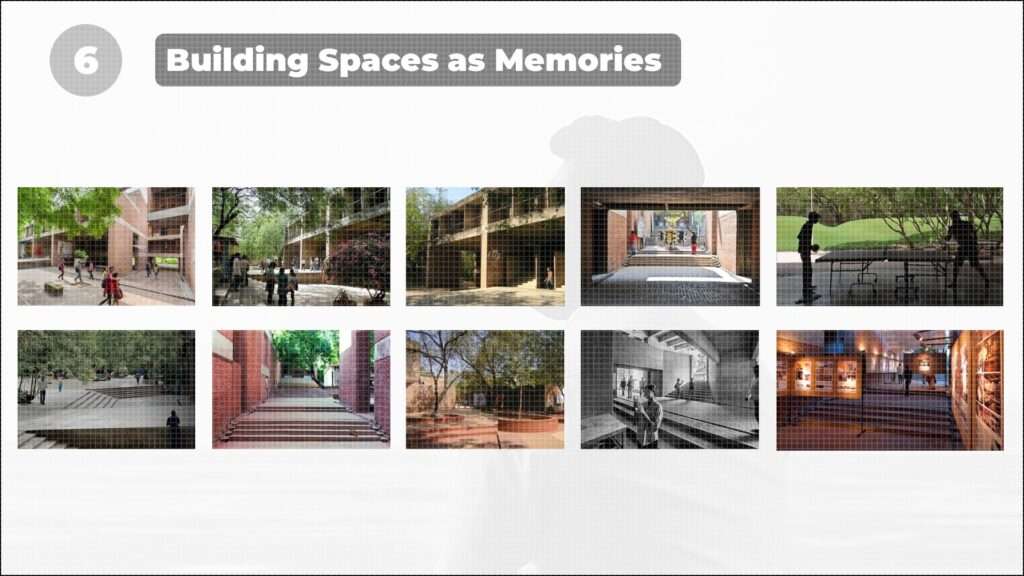Share this Post
- Would you like to learn in a school without any boundaries, limitations, ideas…where living in school campus itself is a great learning experience
- As architects we are always fascinated by some of the phrases which go like “Architecture without boundaries and ideas without limits” and always think of studying in this kind of environment so what if i tell you the case study which we are looking at clearly demonstrates all of that.
- And which is also meant to be the temple of learning
- This temple of learning gave rise to many great architects like Ar. Nimish Patel, Ar.Rahul Mehrotra and Ar. Chitra Vishwanath to name a few and many more
- This is a school which also had the likes of Buckminster Fuller , Louis Kahn and many other world renowned architects visiting and imparting knowledge to the students
- So the school which I am talking about is none other than the Center for Environmental Planning & Technology which we know today as CEPT which was earlier started as the School of Planning & Architecture
- This School was found in 1962, and the task to design this great learning environment was bestowed upon the first Indian Pritzker winning architect B.V. Doshi.
Project Name- Centre for Environmental Planning and Technology
Project Location- Ashram Road, Ahmedabad
Architect- Ar. Balkrishna Doshi
Year – 1972

Introduction
This was the first of its architecture school in India and there was no such great reference, whenever people talked about architecture schools there was always examples of Harvard, Bauhaus but no Indian example and which was the primary reason which architect B.V. Doshi had at the back of his mind.
So the land allocated for the campus used to be a kiln where bricks were produced with some small huts around.
The school initially started with only the architecture department and later on went on to add various other blocks which now functions as multidisciplinary campus
It is spread across 12.5 acres which houses the architecture block with which the school started, interior design school, the recently added Lilavati Library, the Kanoria centre for arts and the Husain Doshi Gufa later.
But In today’s video we will be focusing on the architecture block especially as the same vocabulary continues in the rest of the campus in some or the other way.
So now the question lies what were the genius ideas that lead to converting a brick kiln site into the temple of learning which eventually has become world famous.

Case Study Framework

Brief + Challenges
So the brief that was given to Ar. B.V.Doshi was,
- To Design An Architecture School With Studios, Workshops, Exhibition Space With A Library And Canteen Etc.
But the major, challenges lied in,
- To Design A School For Learning Which Had No Boundaries, No Hierarchies And A Complete Free And Open Environment, Which Emphasized More On Learning Than Teaching
So it was nothing but a “SEARCH” for a new model of education
Planning of the CEPT Campus
The complete site measures 12.5 acres in area with two sides facing the University road and huge lush green trees planted on the periphery which cut the vehicular noise.

The building blocks are added subsequently with years and it’s a growing campus
There are multiple entry points to the campus but the main entrance lies on the northern side of the campus with a simple blank wall which guides to move further and step down to enter the building at the basement level.
The site has a slope and owing to the contours there are various level differences and the blocks are placed at these different levels which get connected by a series of steps which become the hangout spaces or activity spaces
The individual blocks at various levels and are connected by a series of steps which not only help in the transition from one point to another but also become places of unplanned encounters
The steps in fact become external activity hubs with students using the levels for reading, organising informal discussions, performances or even for simply lazing around.

Zoning
- The orientation of the campus is North – South so that the studios get glare free light for working.
- So the ground floor mostly consists of unplanned spaces where many activities can happen and it is left flexible
- And the first floor consists of mainly studio spaces
- Apart from the built spaces the un-built or semi open spaces bring an interesting dimension to the entire campus
- This was broadly the zoning of various spaces but the more interesting thing lies in how the plan was conceived

Decoding the Plan
1) The plan of the building is pretty simple with just two parallel walled bay with two sides open and two sides closed acting as a climatic shield spanned with concrete beams & Kota floor which can be maintained and extended easily, which allows wind to flow thru and blocks the harsh west sun with a blank wall.

2) As compared to the traditional way of having windows as fenestrations, the door here is pushed inside to create a breakout space and also to cut the harsh sun and additionally establishing a visual connect thru the campus

3) The fenestration detail on the North as well as the South side not only add up to the climatic benefit but also become a part of the elevation too which eliminates the need of working on the elevation separately

Form Development

Structure of the Campus
The structure is kept simple with RCC slab and beams used to span horizontally as well as vertically, transferring load to the brick walls and eventually to the foundation
Instead of less no. of beams with greater depths, it is broken into series of small beams which brings about the structural harmony
So here Structure does not merely form in taking load but adding to the building aesthetics throughout the campus

Material Palette
The buildings dressed just in these 4 simple materials which shows its brutalness in elevation
The edge beam depths are kept more so that it helps in spanning the structure as well as becomes an element of strong horizontality

Climatic Response
And it becomes absolutely marvellous of how the building opens itself to take it light and wind for the users inside the building
And how it responds to the climate in which it is situated in
So, what are the steps it takes to react to its surroundings
The 4 major components of the building contributing to the climatic response are –
1) The Parallel Wall Bay Planning

2) Blank South Wall Shield – Shielding the west sun by blank walls
3) Line of Defense – Line of defense acts as a climatic advantage

4) Porosity in Building – Creating porosity by skylights, double ht. spaces, deep recesses which induces the wind flow
Genius Moves by the Architect
And the study would be incomplete without understanding the architect’s smart moves in it
1) Peer to Peer Learning Environment
From this building, the idea of learning from the environment or activities around was propagated to a great extent which is very much needed for the creative professions like architecture & design
So there are pockets of spaces Created intentionally apart from the closed spaces where unplanned encounters take place where there is exchange of ideas
So this is an important move because in architecture more than teachers you learn from your senior peers by hanging out more with them and helping them with their work

2) Binding people together
The campus successfully binds people together thru spatial sequences across all the streams
So there is a harmonious interaction between students of all the years
So now the question lies how it was possible, so it was all because of the volumetric planning instead of a one continuous floor approach
So the Use of levels & double ht. spaces instead of the conventional floor after floor and classroom after approach builds vertical interaction among all the years
So the Visual Participation of People Is Very Important

3) Getting in North Light
And before going to the next move did you take a step back to question as to where exactly the section of this building may have been inspired from?
Have you seen a section of a factory building and the way the north light is taken through them?
So it might have surely been an inspiration for the section!
Using the idea of an industrial typology in an educational campus is a quite genius move in itself
So at the end of the day you can get inspired from anything but it is just a matter of how we use that idea and this example is surely a great one for that

4) Moving of Floor Plates to Create Volumes
The floor plates just pushed to include double & triple height spaces

5) Student In Centre Approach
Most of the times we tend to design as per the areas assigned in the design brief without focusing too much on the end user as to where the student really learns the most and that is in the unplanned encounters

6) Building Spaces as Memories
The building’s spaces really get etched in our memory which we take back with us and that is the beauty of architecture.
So this building leaves with you the memories which often come handy when we sit on our drawing board to design
So if you happen to be in Ahmedabad I definitely recommend you to see this wonderful campus, so that you can relate to each and every detail which I have spoken about

7) Fusion of two ideologies
And lastly, the building leaves us with the overarching experiences of the two masters Le Corbusier and Louis Kahn by,
Bringing in light and creating some dark spaces to create an interesting drama for the light to be appreciated from Kahn
Using the below spaces for multifunctional activities and the brutal show of material aesthetics from Corbusier

8) Learning without Boundaries
And now coming to the end from where it all started that is the brief which was to design a learning environment without and boundaries which was achieved by moving away from the traditional classroom approach towards Open Ended Learning.
So this campus injected this ideology deeply and set an example for the upcoming architecture schools in the country

Conclusion
And lastly, it stands true to b.v. doshi’s quote,
“Architecture must open doors not one but many.”– Ar.B.V.Doshi
So this campus goes beyond the typical book education of inculcating values in students and due to which it is deeply etched in everyone’s heart and has proved to be one the greatest school for architectural education in India.
Do you also feel the same, let me know in the comments below




I am extremely inspired along with your writing skills as neatly as with the format for your blog. Is that this a paid theme or did you customize it yourself? Either way stay up the nice high quality writing, it’s uncommon to see a nice weblog like this one nowadays!